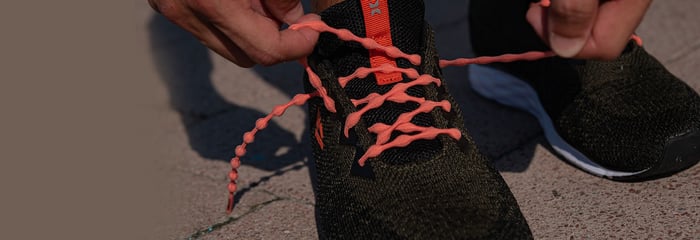
No Tie Required
Caterpy’s no-tie laces keep your shoes tight without killing your feet. Cin7 helps the innovative company scale as it gets more laces to more customers in the US.
Caterpy’s Japan-based founder needed shoelaces that would stay tight without constricting his feet when he ran marathons. There was nothing on the market that fit his requirements, so he invented his own. They were a runaway success.
With Caterpy’s insect-like no-tie shoelaces winning over athletes around the world, the company recruited Anthony Pong as its US Executive Director.
“What really drew me in was that sales in Japan were incredible,” Anthony said. “They were selling a million pairs a year for five years straight, and we wanted to help them expand that even more.”
Stepping Up Sales
Caterpy uses elastic bumps to hold tension throughout the shoe, not the plastic clips that competing no-tie lacemakers use.
Anthony could see that this unique design gave Caterpy a leg up, not just with runners, but also athletes and other consumers who need their shoes to fit without affecting blood circulation.
“Our laces avoid the choke points that you get from tying traditional laces in knots, allowing for better blood flow,” Anthony said. “So our main target was the athletes, but then our secondary target would be the medical communities, selling to people with arthritis or who’ve had surgery and people with diabetes.“
Caterpy today reaches US customers through a mix of B2C and B2B channels, selling its no-tie laces online and in over 300 retail locations.
Spreadsheets Don’t Scale
When Anthony began distributing Caterpy products, it was easy to track inventory and sales using spreadsheets. Over time, the company used different platforms to handle orders in each channel, but the combination of sales growth and order complexity made spreadsheets and unintegrated software too impractical to keep pace with business.
“Scaling was our biggest problem,” Anthony said. “It was hard because our spreadsheets weren’t set up to be used by different users, and it’s hard to scale using different software. So if we pick up different channels, be it WooCommerce, be it Amazon, eBay, whatever, I would have to program an API to make those connections work. So it was just difficult to scale the business.”
Enter Cin7
Now Anthony uses Cin7 to integrate multiple sales channels—WooCommerce, Amazon and eBay—and his 3PL warehouse all in a single solution.
This reduced the data entry and admin tasks that came with managing each sales channel separately and eliminated the cumbersome inventory spreadsheets that made it hard for Anthony’s team to keep pace with orders.
“But the last straw was the ability to map different orders to different general ledger accounts in my accounting software,” Anthony said. “All the other inventory management solutions I saw could only map orders to a single general ledger. Cin7 lets me separate my channels: B2B, B2C, Amazon, whatever it is.”
Mapping sales to alternate GL accounts means that Anthony doesn’t have to look at a bunch of different reports. He can see all his sales right in his QuickBooks Online financial statements.
“Cin7 consolidates all our sales channels and integrations in one place and lets me keep track of inventory in one place and lets me customize order mapping to my accounting system,” Anthony said. “It’s an all-in-one system for my inventory.”



